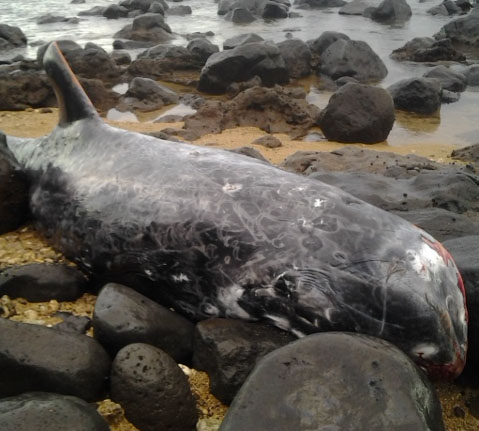Investigation in Death of Rare Risso’s Dolphin off Maui

Preliminary investigation of the adult male Risso’s dolphin (Grampus griseus) by researchers at Hawai‘i Pacific University’s Marine Mammal Stranding Program indicate signs of severe disease in its heart, lungs and stomach. Photo credit: NOAA Permit #932-1905.
By Wendy Osher
For the first time in 25 years, researchers in Hawaiʻi have the opportunity to examine a rare Risso’s dolphin after an adult male stranded itself off Maui’s north shore on Nov. 16.
The dolphin, known by its scientific name, Grampus griseus, weighed an estimated 800 pounds and was about 9-feet long, HPU researchers said.
Researchers at the Hawaiʻi Pacific University’s Marine Mammal Stranding Program say a preliminary investigation indicates the animal suffered from severe disease in its heart, lungs and stomach.
“The animal had a dilated and weakened right heart ventricle with associated irregular coronary vasculature, and congested lungs,” said Gregg Levine, a contract veterinarian with the National Oceanic and Atmospheric Administration in a statement.
“Multiple firm masses were noted in the stomach in addition to a large gastric ulcer. The animal was quite thin, and there was no food or prey items noted in the digestive tract which is indicative of a chronic illness in this individual” said Levine.
HPU’s Kristi West, PhD, also noted that a plastic bag was found in the dolphin’s esophagus, which she said most likely did not cause its death, but serves as a reminder of the reach of man-made debris.
West said work continues on samples to establish the exact cause of death. “This unusual stranding event provides a very rare opportunity for us to learn about one of the most poorly known dolphin species found in Hawaiian waters and threats they face,” she said.
According to Dr. West, a separate stranding was reported off of Maui in 2007, but the Risso’s dolphin in that incident was able to swim away when a shark entered the area, and “was not sighted again.”
According to information released by HPU, researchers say Risso’s dolphins are seldom sighted in Hawaiʻi, and are usually found in great depths far from shore.
“They are also unique in appearance, with a bulbous head and extensive natural scarring patterns on older animals,” according to HPU researchers.
Others agencies that assisted with the Maui stranding included: the state DLNR Maui Division of Conservation and Resource Enforcement and Division of Forestry and Wildlife, fire crews from the Pāʻia Station, volunteers from the NOAA Fisheries Maui Marine Mammal Response, and local cultural practitioners, including one who was on-scene to perform protocol and eventually return the animal’s remains to the ocean, according to officials at HPU.









